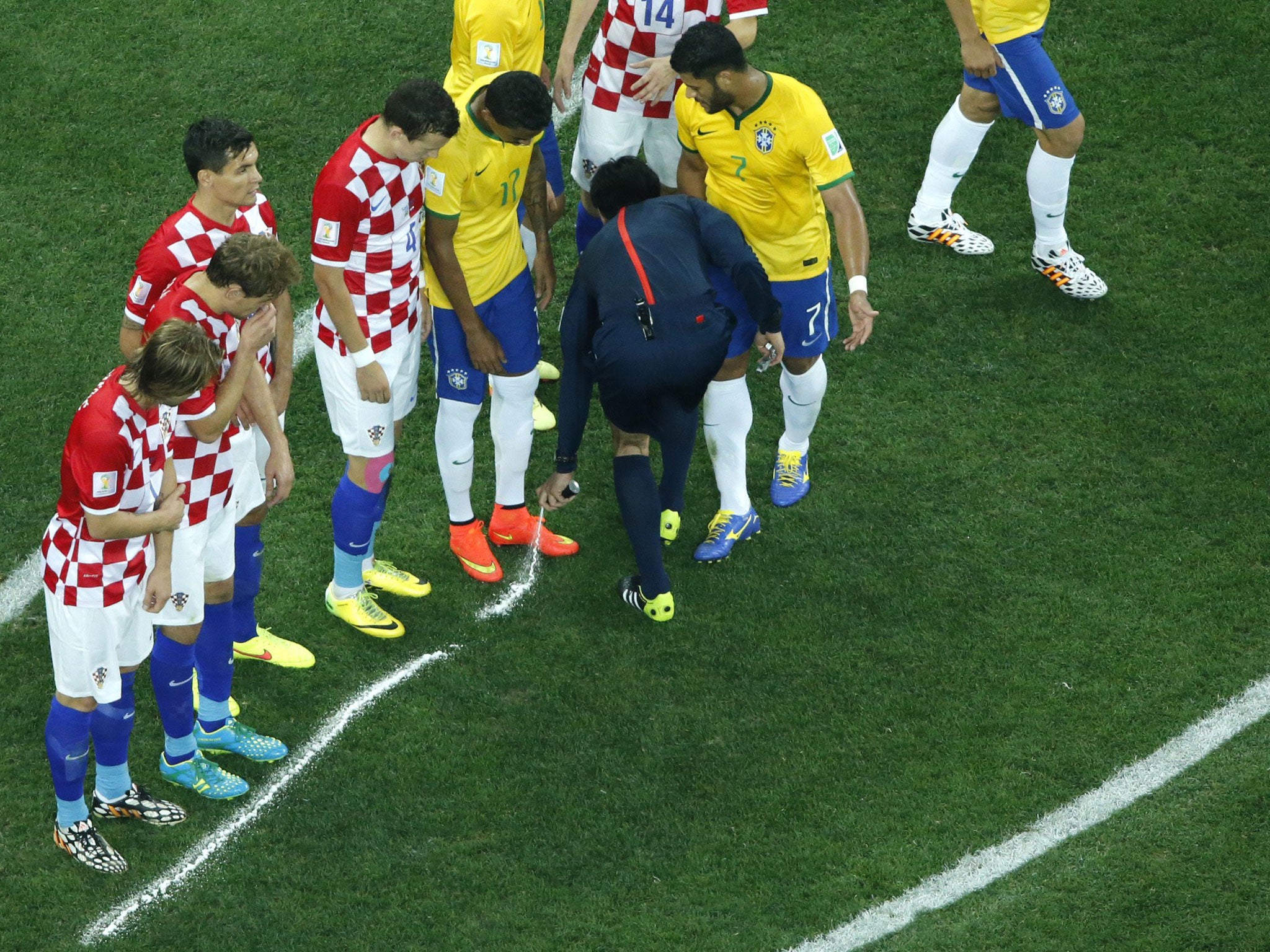World Cup 2014: Spray’s the way to try to force players into toeing the line and Cristiano Ronaldo is a fan
On Thursday Yuichi Nishimura put down the first line in World Cup history

It’s Colombia to the north that’s more readily associated with vanishing white lines, but the white spray being painted by referees on to Brazil’s World Cup pitches has already left an indelible mark on the game, though not the grass.
With the riot police outside putting their tear-gas canisters back in their holsters, Japanese referee Yuichi Nishimura took his own spray-can out from a holster on his belt and put down the first line in World Cup history.
It was shortly before the end of the first half of the tournament’s opening match on Thursday when he awarded Brazil a free-kick against Croatia 25 yards from goal. The line, drawn 10 yards from the ball, is intended to stop defenders creeping or rushing forward when an attacking free-kick is taken, which it is hoped will lead to more goals being scored direct from free-kicks.
In the end, the Brazilian free-kick went wide of the target. In the past 10 years or so, major tournaments have been extremely low on goals resulting from direct free-kicks, but with the advent of these little spray- cans, that may change.
There are few sights more joyous in football than a magisterial free-kick bent into the top corner of the net. To do this, players almost always have to get the ball over a wall of defenders, but not so high as to prevent it dipping back down again and into the goal. If the wall is too close, this becomes much harder to achieve.
However, the evidence is clear so far that the white-line tactic is proving only partially successful. Defenders dutifully line up behind the spray, but when the attacker begins his run-up they have been moving forward, ending up over the line by the time boot strikes ball.
The so called “vanishing spray”, a type of foam that disappears in under a minute, has been a novel sight for European viewers, but has been in use in Brazilian domestic leagues for eight years.
Pablo Silva, an Argentinian journalist, claims to have invented the spray after having the idea when driving home in a rage after seeing the opposition defence charge forward and block his crucial free-kick in an old boys’ tournament.
“In the 88th minute we were losing 1-0 and won a free-kick on the edge of the area. When I took the kick, the wall [of opposing players] was three metres away. The referee didn’t book anyone and didn’t do anything.
“We lost the game, and driving home later with a mixture of anger and bitterness, I thought that we must invent something to stop this,” he explained.
The spray’s brand name is 9:15 Fairplay, 9:15 being 10 yards expressed in metres. Cristiano Ronaldo, who will certainly be hoping to bury a few free-kicks of his own for Portugal over the next few weeks, has called it “a great idea”, and it has been welcomed by many other players as well.
But quite how much of a game-changer it will prove to be is open to question. In the 2010 World Cup there were just five goals scored directly from free-kicks, out of a total of 145 goals in the whole tournament. In 2010 and 2006 there were nine.
In the leagues where the spray is already in use – in Brazil, Argentina and also Major League Soccer in the US – there is no conclusive evidence that adopting its use has resulted in more goals from free-kicks.
World Cup 2014: Brazil 3 Croatia 1 - player ratings
Show all 22There are no plans as yet to introduce it to the Premier League, though there is already a clamour to do so. But if World Cup 2014 does after all leave us with indelible memories of a plethora of screaming free-kicks, you can be sure the spray will be here to stay.
Subscribe to Independent Premium to bookmark this article
Want to bookmark your favourite articles and stories to read or reference later? Start your Independent Premium subscription today.

Join our commenting forum
Join thought-provoking conversations, follow other Independent readers and see their replies